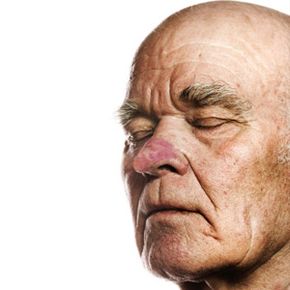Located front and center on your face, your nose can say a lot about you. A swollen, runny nose, for example, lets everyone know a cold or allergy has taken over. If the skin on your nose is bright red and peeling after a day in the sun, it tells everyone you forgot your sunscreen. Even a small pimple seems to take on a life of its own when it pops up on the tip of your nose. So when you develop a more serious skin condition in your nasal area, like rhinophyma, it can raise a red flag quickly.
Rhinophyma is a severe skin condition characterized by a red, inflamed and bulbous nose [source: Medline Plus]. In people with rhinophyma, the skin on the nose gets thicker, becomes bumpy and may take on a yellowish tone. The facial pores become enlarged, and the number of oil-producing glands in the skin may increase. Ultimately, the condition can become so pronounced that the tissue around the nose swells and grows to a point where the nose is disfigured. Like many skin conditions, rhinophyma doesn't develop overnight. It is the last stage in the progression of acne rosacea, a skin disorder that affects the face [source: International Rosacea Foundation].
Advertisement
While researchers have documented rhinophyma cases in people as young as 20, it generally occurs in Caucasian men in their 40s to 60s [source: Baylor College of Medicine]. Rhinophyma can affect both men and women; however, it is 12 times more likely to occur in men. Despite those odds for men, it is still considered a rare skin disorder.
To better understand this condition, read on to learn more about rosacea and the progression to rhinophyma.
Advertisement

